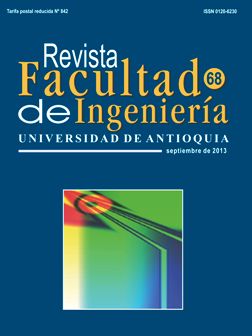A heuristic decomposition method for large-scale traffic assignment: Aburra Valley case study
DOI:
https://doi.org/10.17533/udea.redin.17225Keywords:
traffic assignment problem, large-scale model, decomposition methods, heuristicsAbstract
Traffic assignment is one of the most important stages in transportation planning; however, its application to real case studies in medium- to largesized cities makes the solution of the model difficult because of the scale and high computational complexity related to the combinatorial and non-linear nature of the problem. The aim of this paper is to present a decomposition method based on sub-region analysis, and a simple heuristic rule for solving large-scale traffic assignment problems. This reduces the total amount of variables and equations of the model and offers a practical solution in a reasonable computing time. The proposed traffic assignment model is applied to the multimodal main road network of the Aburra Valley, Colombia. Such an application of a great amount of variables and equations converts the model into a large-scale problem. The proposed method considerably reduces the computational complexity of the problem, and it reveals accurate solutions in an execution time which is reasonable for such a large-scale model.
Downloads
References
M. McNally. “The four-step model”. Hensher and Button Editors. Handbook of Transport Modeling. Ed. Pergamon. Amsterdam, The Netherlands. 1st ed. 2000. pp. 35-52.
J. Ortuzar, L. Willumsen. Modeling transport. 4th ed. Ed. John Wiley and Sons. London, U.K. 2011. pp. 606.
J. Wardrop. “Some theoretical aspects of road traffic research.” Proceedings of the institute of civil Engineers. Vol. 2. 1952. pp. 325-378. DOI: https://doi.org/10.1680/ipeds.1952.11259
M. Beckman, C. McGuire, C. Winsten. Studies in the economics of transportation. 1st Ed. Yale University Press. New Haven. USA. 1956. pp. 226.
H. Bar, D. Boyce. “Origin-Based Algorithms for Combined Travel Forecasting Models”. Transportation Research. Vol. 37B. 2003. pp. 403-422 DOI: https://doi.org/10.1016/S0191-2615(02)00020-6
I. Thomson, A. Bull. “La congestión del tránsito urbano: Causas y consecuencias económicas y sociales.” Revista de la CEPAL. Vol. 76. 2002. pp. 109-120. DOI: https://doi.org/10.18356/fd4a1f83-es
Sheffi, Y. Urban Transportation Networks: Equilibrium Analysis with Mathematical Programming Techniques. 1st ed. Ed. Prentice Hall. Englewood Cliffs, USA. 1985. pp. 415.
K. Davidson. “A flow-travel time relationship for use in transportation planning”. Proceedings of Australian Roads Research Board. 1st ed. Melbourne, Australia. 1966. pp. 183-194.
M. Florian. “A traffic equilibrium model of travel by car and public transit modes.” Transportation Science. Vol. 11. 1977. pp. 166-179. DOI: https://doi.org/10.1287/trsc.11.2.166
F. Babonneau, J. Vial. Test instances for the traffic assignment problem. Technical Report, Ordecsys. Geneva, Switzerland. 2008. pp 1-5.
L. Lasdon. Optimization theory for large scale systems. 2nd ed. Ed. Dover Publications. Mineola, USA. 2002. pp. 560.12. M. Frank, P. Wolfe. “An Algorithm for quadratic programming.” Naval Research Logistics Quarterly. Vol. 3. 1956. pp. 95-110. DOI: https://doi.org/10.1002/nav.3800030109
D. Hearn, S. Lawphongpanich, et al. “Restricted Simplicial decomposition: Computation and extensions.” Mathematical Programming Study. Vol. 31. 1987. pp. 99-118. DOI: https://doi.org/10.1007/BFb0121181
T. Leventhal, G. Nemhauser, et al. “A column generation algorithm for optimal traffic assignment.” Transportation Science. Vol 7. 1973. pp. 168-176. DOI: https://doi.org/10.1287/trsc.7.2.168
T. Larsson, M. Patriksson. “Simplicial decomposition with disaggregated representation for the traffic assignment problem.” Transportation Science. Vol 26. 1992. pp. 4-17. DOI: https://doi.org/10.1287/trsc.26.1.4
M. Patriksson. The traffic assignment problem, models and methods. Ed. VSP. CRC Press. Utretch, The Netherlands. 1994. pp. 222.
Área Metropolitana del Valle de Aburrá (AMVA). “Informe Final. Diagnóstico”. Formulación del Plan Maestro de Movilidad para la Región Metropolitana del Valle de Aburrá. Consorcio Movilidad Regional Colombia-Chile. Medellín, Colombia. 2007. pp. 102- 188
GAMS. General Algebraic Modeling System. Avaliable on: www.gams.com. Accessed: December 2011.
B. Murtagh, M. Saunders. MINOS 5.51 user’s guide. Report SOL 83-20R, Revised in 2003, Systems Optimization Laboratory, Stanford University.Avaliable on: http://www.stanford.edu/group/SOL/guides/minos551.pdf. Accessed: March 2012.
Downloads
Published
How to Cite
Issue
Section
License
Copyright (c) 2018 Revista Facultad de Ingeniería

This work is licensed under a Creative Commons Attribution-NonCommercial-ShareAlike 4.0 International License.
Revista Facultad de Ingeniería, Universidad de Antioquia is licensed under the Creative Commons Attribution BY-NC-SA 4.0 license. https://creativecommons.org/licenses/by-nc-sa/4.0/deed.en
You are free to:
Share — copy and redistribute the material in any medium or format
Adapt — remix, transform, and build upon the material
Under the following terms:
Attribution — You must give appropriate credit, provide a link to the license, and indicate if changes were made. You may do so in any reasonable manner, but not in any way that suggests the licensor endorses you or your use.
NonCommercial — You may not use the material for commercial purposes.
ShareAlike — If you remix, transform, or build upon the material, you must distribute your contributions under the same license as the original.
The material published in the journal can be distributed, copied and exhibited by third parties if the respective credits are given to the journal. No commercial benefit can be obtained and derivative works must be under the same license terms as the original work.










 Twitter
Twitter